
This article deals primarily with the goddess Aphrodite (Venus), the goddess of love and sex, the ultimate in female beauty. It is not surprising that she has inspired many artists of both ancient and modern times. For the birth of Aphrodite, see The Titans.
The final set of images illustrate two other Olympians with whom she had close a relationship: Hephaestus the blacksmith and Ares the god of war.
Contents
Ranking as one of the masterpieces of art from ancient Greece was a marble sculpture by Praxiteles, an artist active between 350-330 B.C. Centuries after his lifetime, the Roman author Pliny tells a story behind the creation of this work, which he said was "not only the finest sculpture by Praxiteles, but the finest in the whole world". Pliny relates how Praxiteles had received a commission from the people of the island Cos for an image of Aphrodite, and he depicted her completely nude, which was not common at that time. The people of Cos were shocked by this explicit figure, and requested another, a more modest clothed version.
But the city of Knidos eagerly desired the first statue, and proudly displayed it, becoming one of the great tourist attractions of the Greek world (Knidos is actually in Asia Minor, not Greece itself). Pliny even records an incident about an obsessive fan of the statue who managed to 'spend the night' with it, the evidence being visible the next day.
Unfortunately, we no longer have the original statue itself, but we do have copies of it that were made some time afterwards. (Images one, two, three, four, five. Two, three and four are the same fragment). This copying of notable Greek works was an especially common practice in Roman times, and is our only source for knowing what some things looked like. These can give us a sense, an impression, of how the original would have appeared, even if they cannot capture its artistic subtleties. Put more simply, a mediocre copy is better than none at all.
The last image below is a Roman copy of another Aphrodite by Praxiteles, in which she is only partially nude, know as the Venus of Arles. There is undeniably a relationship between this sculpture and the next, the well-known Venus de Milo, as we are about to see.
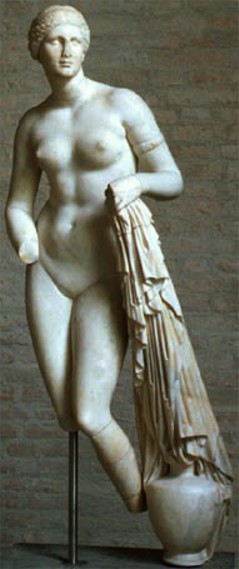
one
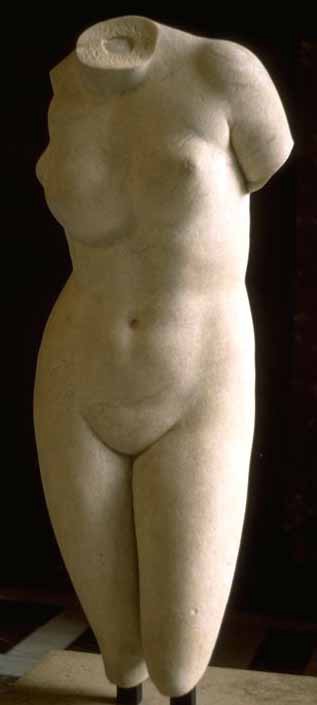
two
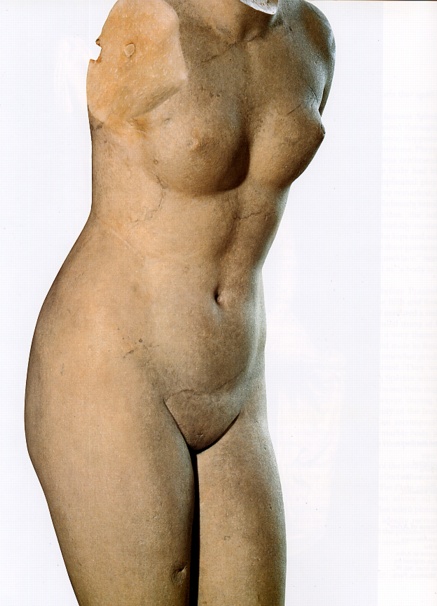
three

four
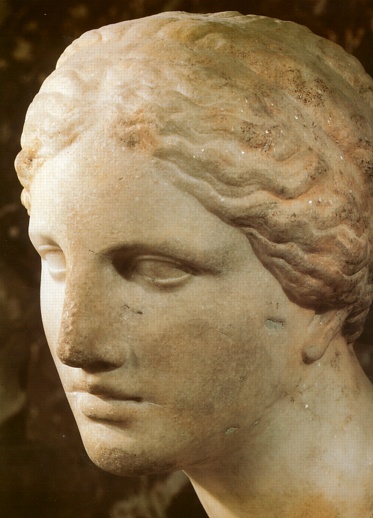
five
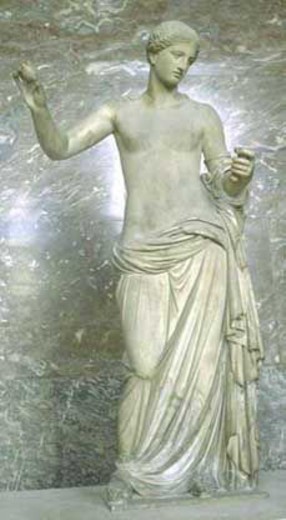
Arles
This is one of the few works of ancient art that is widely known among the general public, if only the name. But a far smaller number of people would be able to tell you what "de Milo" means, or when it dates from, or how it is related to other sculptures of this goddess. Here are the answers: first, the name "de Milo" derives from the French spelling of the Greek island Melos (literally "Venus from Melos"),where the figure was discovered in 1820. French officials who learned of the discovery negotiated its acquisition from the Turks who controlled Greece at that time, and it has been on display at the Louvre ever since.
When it was presented to the king of France, it was claimed to be a work by Praxiteles, the sculptor of the famous Knidos statue mentioned above, but this proves to be wishful thinking at best, or a fraud at worst. For in fact a fragment of the base with an inscription naming the artist as (Ages?)andros of Antioch had been discovered, but this piece went mysteriously missing, but not before it was recorded in drawings. Nothing else is known of this sculptor, so he does not seem to have been a major one, just one of many working in the Hellenistic period, about 100 B.C.
As we noted above, Praxiteles is known to have produced a semi-clothed Aphrodite, and this was copied and recopied, and variations of it were made as well. One of the better of these Praxiteles-inspired works is known as the Venus of Capua (in fact there are several known copies of this in existence), where the goddess was holding a shield (now missing) which she was using as a mirror to look at herself.
This brings us to the Venus de Milo, which is apparently a variation of the Venus of Capua, which was itself a variation of the Venus of Arles. When one looks at the Venus de Milo as the result of several generations of artists making similar statues, it can be seen in a new light. (Images one, two, three, four) And that light is not necessarily favorable. The Venus de Milo is not a great masterpiece from the high point of Greek sculpture, rather it is a somewhat bland, derivative work produced in the later Hellenistic, 250 years after Praxiteles.
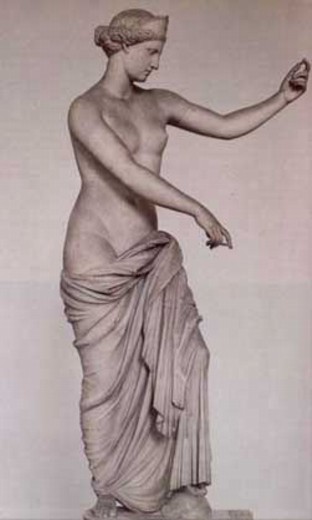
Capua

one
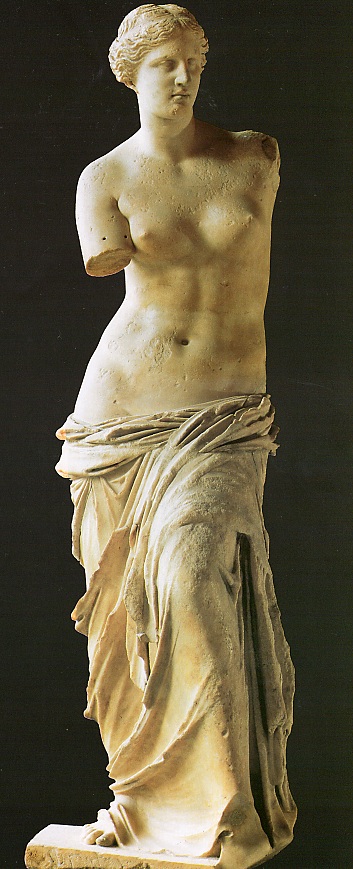
two
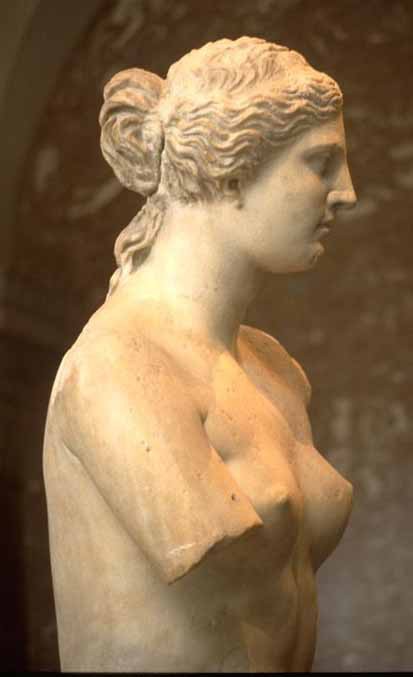
three
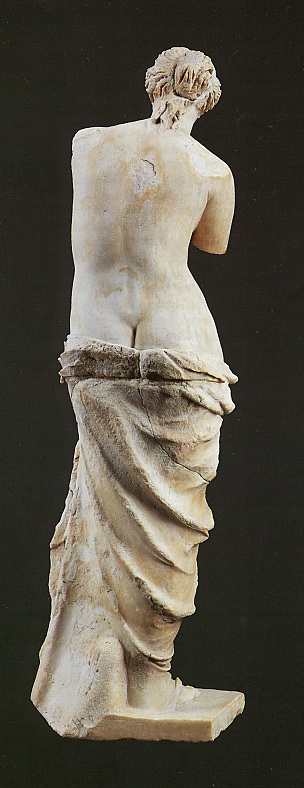
four
By coincidence, this next sculpture dates to the same time period as the Venus de Milo, approximately 100 B.C., so it would also be considered a Hellenistic work, although it is only about half life-size. Some art critics feel that this figure is a somewhat crude variation of the Praxiteles-Aphrodite described previously, making it more salacious by adding the obvious sexual overtones of the lustful figure of Pan.
Whether or not one sees it as being in poor taste, it is a finely crafted work, one of the better pieces from the late Hellenistic period. Unlike the Venus de Milo, we have specific information on who owned this piece and where it was located. It was found on the island of Delos, famous as the birthplace of the god Apollo. Delos in historical times was a center or stopover for overseas merchants. The building where this figure was found was a house or lodge belonging to Syrians, not Greeks. These Syrians, known as the Poseidoniasts, were noted slave-traders of the time. It is interesting that these foreigners chose to decorate their building with fine Greek art, rather than that of their native land.
It is apparently an original composition of the unknown sculptor, since there is no known myth of these two to go along with it. Yet the scene makes sense in that Pan is lustful, Aphrodite is sexual, and an encounter between the two would seem to have been inevitable.
But as there is no known story, it is difficult to know exactly what is transpiring between them, although Pan's amorous intentions seem fairly obvious. What is uncertain is her reaction—is her raised sandal a come-on, a tease, or is she perhaps threatening to strike him with it because she isn't interested?

one
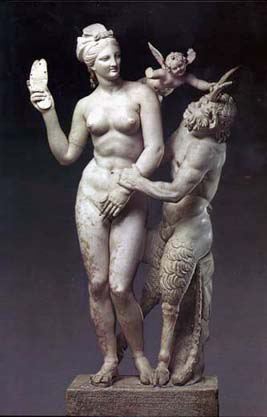
two

three
Several works from the buried city of Pompeii depict the goddess and her associates. You may already have seen the first image in The Titans as a representation of her birth fom the sea. The house where this is located is now named the "House of Venus".

Birth
The second image is a small marble figure of Venus preparing to bathe. Notice the added gold-leaf 'bikini'. Also visible is a small male figure on which she is leaning. This is her offspring Priapus, a fertility god recognized by his oversized phallus, which has broken off in this example.

Gilded
Finally, we have another wall painting of Venus sitting close to her lover, the god of war Mars. She is holding his spear while the little Cupid below tries on his warrior's helmet. We will see more of this couple later.
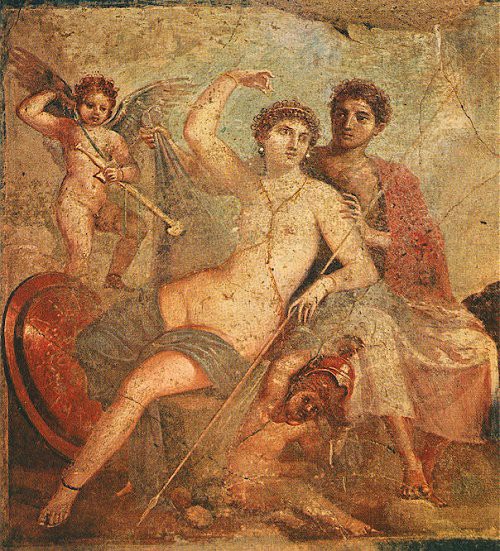
Venus & Mars
Sandro Botticelli (1445-1510) was one of the major artists of the Italian Renaissance, who became known primarily through his work for the powerful Medici family of Florence. It was through this connection that he became influenced by Neoplatonist philosophy, and some of his most notable paintings incorporate these philosophical concepts in the form of allegories using mythological characters, especially Venus.
We have already seen his famous Birth of Venus in The Titans. The first image here is another featuring the goddess, entitled Calumny. This was actually based on a lost ancient Greek painting by an artist named Apelles (4th c. B.C.), which had been described by a writer named Lucian (2nd c. A.D.). Working from his written description, Botticelli portrayed the scene to match Lucian's text as closely as possible.

Calumny
Calumny (a word meaning false accusation or slander) is represented as an attractive female holding a torch and dragging her victim by the hair before a figure with ass' ears symbolizing Authority. Two figures, Ignorance and Suspicion, whisper to Authority, as two others, Treachery and Deceit, arrange Calumny's hair and clothes, while a scrawny figure representing Envy gains a hearing for Calumny.

Detail from Calumny
In the detail, we see a close-up of the two figures on the far left. First, an old woman representing Repentence or Regret, who always arrives late, and then Venus as the naked Truth, who points to the heavens. Her nudity and gesture indicate that Truth is openly visible, the greatest beauty of all, and concerned with heaven, not the worldly matters such as Calumny.
The painting below is titled Primavera (Springtime), and it also features Venus, visible in the center, with a Cupid hovering above her. Unlike the Calumny, we cannot be as certain of the specific significance of each figure. At the very least, the painting appears to be a study of Love in its many forms, as described in Platonic philosophy. On the right, the west wind Zephyr pursues a maiden named Chloris, who transforms into the next figure, Flora, the pregnant goddess of bounty and blooming. On the left side of Venus are the three Graces (more on them below) and finally Hermes (Mercury) said to be "scattering mists with his rod", apparently a symbol of spiritual inspiration.

Primavera
Finally, a simpler composition, titled Venus and Mars. The meaning seems quite clear: She has 'defeated' her lover, the god of war himself, or in other words, Love conquers All.
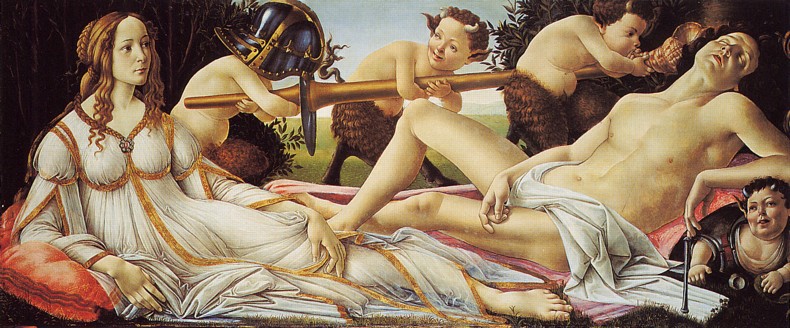
Venus & Mars
Although Aphrodite had numerous affairs, they were generally with gods. She only rarely took mortal men as her lovers. One of these very few relationships was with a man from Troy named Anchises, described in an early poem entitled the Homeric Hymn to Aphrodite. This poem begins with the goddess mocking the other Olympians, even Zeus, for having affairs with mortals, so Zeus decided to punish her arrogance by compelling her to be attracted to a human.
She came to earth in the appearance of a beautiful foreign princess from a distant land who 'just happened' to encounter Anchises in the region near Troy while he was spending the night outside of the city. He was irresistably attracted to this woman, and they slept together. It was not until the next morning that Anchises discovered the woman he had just been with was Aphrodite herself.
The product of this affair was a son named Aeneas, who became one of the great heroes of later myths. Especially important is the Roman poem known as Vergil's Aeneid, which describes how Aeneas survived the Trojan War, eventually migrated to Italy, and started what would one day become known as Rome. Thus the entire Roman culture considered Aeneas as their founding father, who was the son of Venus herself.
The image below is one of the panels from the Farnese Gallery by Anibale Carracci. The key to identifying this couple is the tablet below with the words GENUS UNDE LATINUM, meaning "from where (comes) the Latin race," referring to the future destiny of their son Aeneas.

Carracci
Next is another wall painting from Pompeii, showing Aeneas in a scene from the Aeneid having his wounds tended, with his divine mother arriving with some healing herbs in the upper left.
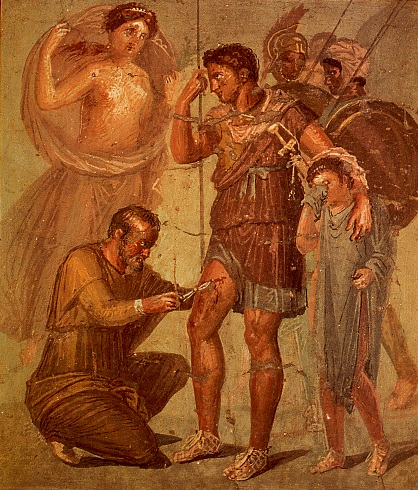
Pompeii
This myth is set on the island of Cyprus, a place which was especially sacred to Aphrodite, because it was the first place she set foot on land after emerging from the sea. Thus she was especially offended to learn that the women of Cyprus were denying her worship. As punishment, the goddess turned them all into wicked, undesirable prostitutes.
But one man on Cyprus decided if he couldn't find the right woman, he would create her. Using his skill as a sculptor, Pygmalion fashioned a statue in the likeness of his ideal woman (some say it was modelled after Aphrodite herself), which Pygmalion treated as if it was a real woman, carrying on conversations with it and bringing her little presents, even kissing and carressing it. Pygmalion prayed that his statue might truly become a real woman, a wish that was granted by Aphrodite in return for his devotion. When he returned to his studio, Pygmalion was amazed to discover that his statue was now a living woman, who was named Galataea.
We see two versions of the story below: first a four-painting series by Edward Burne-Jones, one of the notable Pre-Raphaelites of the 19th Century.

Burne-Jones 1

Burne-Jones 2

Burne-Jones 3

Burne-Jones 4
The second pair of images shows two variations of the subject by the same artist, Jean-Léon Gerome. The first version seen here is later, and better known, than the second. Perhaps he decided the frontal nudity of the early version was too much for the public of 1881.

Gerome 1
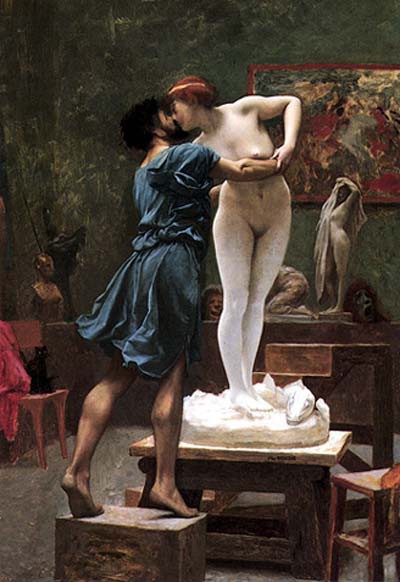
Gerome 2
Eros was the embodiment of sexual desire (and the root of the English word 'erotic'), and often depicted in human form as the offspring of Aphrodite, armed with his arrows which can arouse love (or hatred) in his victims. But who was the father? Some ancient sources say it was Hermes (Mercury) but others say it was Ares (Mars), the god of war, from whom he inherited his skill with the bow. Occasionally we will see multiple Cupids (or Erotes) in a picture. There was a tradition that there were in fact two kinds of Eros, the one who dealt just with the gods' affairs (the son of Aphrodite) and the many (the minor ones who deal with mortals).
The first image here is a white-ground vase painting by Douris, with Eros appearing as a young man.

Douris
More common is the depiction of him as a child, as in the (copy of a) Hellenistic sculpture by Lysippus below, and in the painting by Caravaggio (which is sometimes known as "Lust destroying Culture").
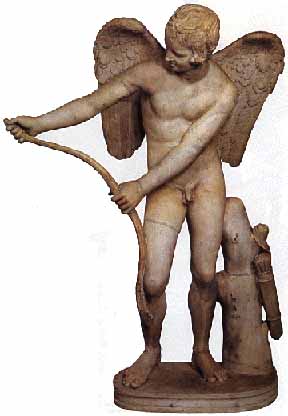
Lysippus
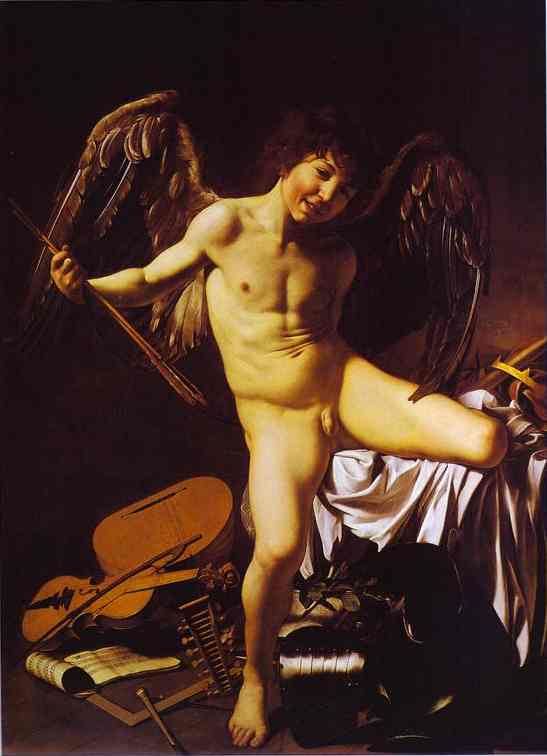
Caravaggio
Next is a painting by Antonio da Correggio which follows the tradition that Hermes (Mercury) was the father.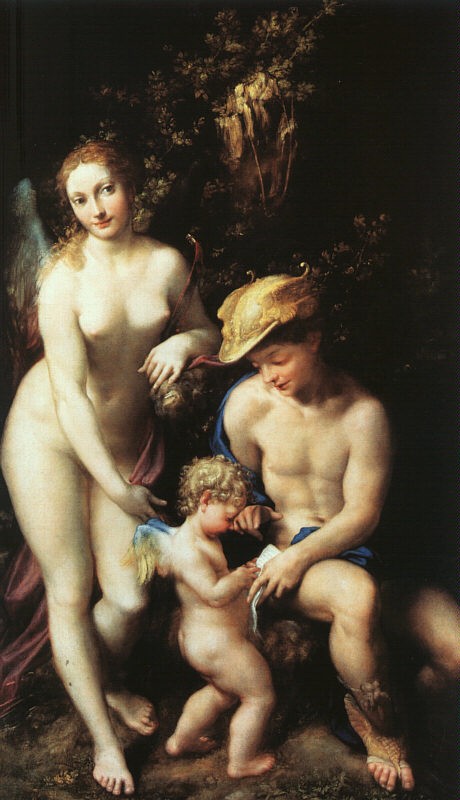
Correggio
And finally a painting by Pompeo Batoni, based on the story of the wedding of Cupid and Psyche.
In this story, the girl Psyche was so beautiful people called her "the new Aphrodite." This angered the real Aphrodite, who sent Cupid to punish the girl, but instead he fell in love with her and after many trials and tribulations, they were eventually married. Although she objected at first, his mother finally gave her consent and can be seen in her dove-drawn chariot on the left. The real message of this story is that true happiness comes from the uniting of desire (Cupid) with the soul (Psyche).
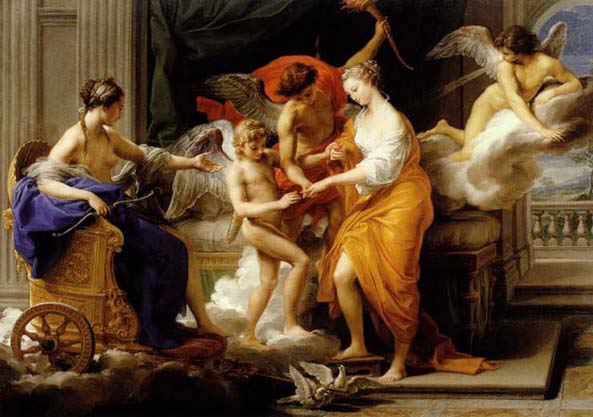
Batoni
Along with Eros, the most frequently seen companions of Aphrodite are her attendants known as the three Graces, daughters of Zeus who personify charm, grace and beauty. They are almost always shown in the same pose, as seen below.
The first view is a Hellenistic sculpture, followed by a Pompeiian wall painting. Two from the Renaissance show a detail from Botticelli's Primavera, and a version by Raphael.

Hellenistic

Pompeii

Botticelli
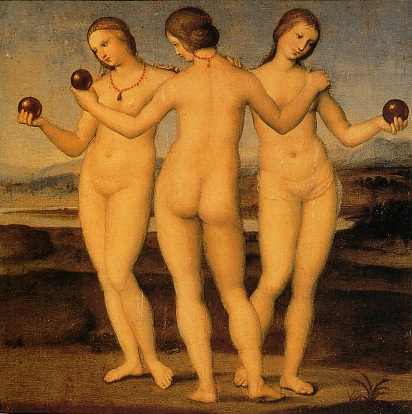
Raphael
The last one, by Rubens, is at least at bit unique. Rubens is known to have found larger women more attractive, and it shows here. In fact, the model for the figure on the right was the woman Rubens married.

Rubens
Of all her many lovers, we have yet to mention her husband, the blacksmith god Hephaestus (Vulcan). Their marriage was not an ideal one, having been arranged by Zeus as somewhat of a joke: the most beautiful goddess married to the most unattractive god, for Hephaestus was said to be ugly and crippled. Even his own mother Hera disliked him.
But one day he got his revenge on her by trapping her on a chair (or throne) which only he could unlock, which he refused to do. Only after Dionysus, the god of wine, got him drunk was he persuaded to return to Mt. Olympus (depicted in the red figure vase painting below) to release Hera.

Red Figure
Despite her extramarital affairs, Aphrodite could always rely on her husband for his metalworking skills. Here are two similar paintings (one by Joseph Natoire, the other by Gaetano Gandolfi) which have the same subject: Aphrodite arriving at her husband's workshop to collect a set of arms for her son Aeneas, introduced earlier.

Natoire

Gandolfi
Of all her affairs, the most intense was the ongoing one with Ares (Mars), the handsome god of war. We have already examined a few images of them together. The two final images show the couple together.
First, the painting by Paolo Veronese (1528-1588).

Mars and Venus United by Love - Veronese (1570s)
Next, a second look at Mantegna's Parnassus. This painting was featured in Prometheus, Pandora because it includes the nine Muses dancing below. Now we direct our attention to the couple in the upper portion, Ares and Aphrodite. Off to the left side, you can see her husband Hephaestus at his forge, gesturing angrily towards his unfaithful wife.

Parnassus - Mantegna (1497)
The poet Homer tells the tale of how Hephaestus eventually caught the two of them together. It was Helios the sun god who informed Hephaestus of what he observed as he drove his chariot across the sky. This scene appears below in the painting by Diego Velazquez. (In the stories, his assistants are usually said to be Cyclopes, one-eyed giants, although they appear as normal humans here.)

The Forge of the Vulcan - Velazquez (1630)
In the second image here, by Tintoretto, one of the two most notable Renaissance artists from Venice (the other is Titian, 30 years older than Tintoretto), the artist chose a unique moment in the story, not actually detailed by Homer. Hephaestus has come home to catch his wife in the act with her lover, but is just a little too late. He senses what has been going on, but does not notice that Ares is hiding under the table. The setting of the room is contemporary with the Venice of Tintoretto's era.

Venus, Vulcan and Mars - Tintoretto (1550)
For the rest of Homer's story, we have the last image here by Jacob van Heemskerck. Hephaestus crafted a trap, a sort of net of chains, which he concealed in the frame of the couple's bed. As soon as he left, Ares came to her but once they laid in the bed, the trap was sprung and they were pinned. Hephaestus then invited the other gods of Olympus to see how shameful Aphrodite was.

van Heemskerck (1634)